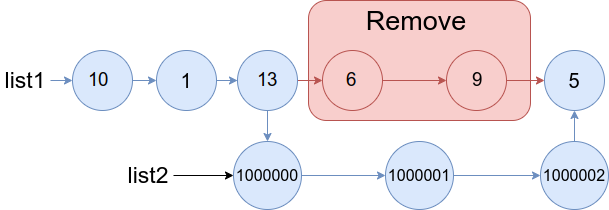Description
You are given two linked lists: list1 and list2 of sizes n and m respectively.
Remove list1’s nodes from the ath node to the bth node, and put list2 in their place.
The blue edges and nodes in the following figure indicate the result:

Build the result list and return its head.
Example 1:

Input: list1 = [10,1,13,6,9,5], a = 3, b = 4, list2 = [1000000,1000001,1000002] Output: [10,1,13,1000000,1000001,1000002,5] Explanation: We remove the nodes 3 and 4 and put the entire list2 in their place. The blue edges and nodes in the above figure indicate the result.
Example 2:

Input: list1 = [0,1,2,3,4,5,6], a = 2, b = 5, list2 = [1000000,1000001,1000002,1000003,1000004] Output: [0,1,1000000,1000001,1000002,1000003,1000004,6] Explanation: The blue edges and nodes in the above figure indicate the result.
Constraints:
3 <= list1.length <= 1041 <= a <= b < list1.length - 11 <= list2.length <= 104
Code
Time Complexity: , Space Complexity:
照題目要求操作而已,沒啥難的。
/**
* Definition for singly-linked list.
* struct ListNode {
* int val;
* ListNode *next;
* ListNode() : val(0), next(nullptr) {}
* ListNode(int x) : val(x), next(nullptr) {}
* ListNode(int x, ListNode *next) : val(x), next(next) {}
* };
*/
class Solution {
public:
ListNode* mergeInBetween(ListNode* list1, int a, int b, ListNode* list2) {
ListNode** iter = &list1;
for(int i = 0; i < a; i++) {
iter = &(*iter)->next;
}
ListNode* next_iter =(*iter)->next;
// connect to list2's start
*iter = list2;
for(int i = 0; i < b - a; i++) {
next_iter = next_iter->next;
}
while(list2->next) {
list2 = list2->next;
}
list2->next = next_iter;
return list1;
}
};